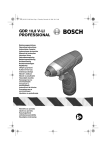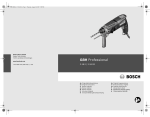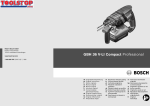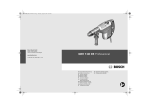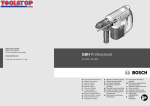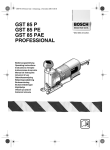Download Bosch GBH 4-32 DFR Professional Operating instructions
Transcript
OBJ_BUCH-337-001.book Page 1 Monday, May 7, 2007 10:34 AM GBH 4-32 DFR Professional Bedienungsanleitung Operating instructions Instructions d’emploi Instrucciones de servicio Manual de instruções Istruzioni d’uso Gebruiksaanwijzing Betjeningsvejledning Bruksanvisning Brukerveiledningen Käyttöohje Οδηγία χειρισμού Kullanım kılavuzu Instrukcja obsługi Návod k obsluze Návod na používanie Használati utasítás Руководство по эксплуатации Інструкція з експлуатації Instrucţiuni de folosire Ръководство за експлоатация Uputstvo za opsluživanje Navodilo za uporabo Upute za uporabu Kasutusjuhend Lietošanas pamācība Naudojimo instrukcija OBJ_BUCH-337-001.book Page 3 Monday, May 7, 2007 10:34 AM A x B C 3 1 619 929 774 • 7.5.07 OBJ_BUCH-337-001.book Page 4 Monday, May 7, 2007 10:34 AM D 3 E 12 13 14 GRIP, ZU RELEASE, AUF F 9 G X 15 4 16 17 18 19 20 1 619 929 774 • 7.5.07 OBJ_BUCH-337-001.book Page 5 Monday, May 7, 2007 10:34 AM 6 5 7 1 4 3 2 11 10 9 8 GBH 4-32 DFR Professional 5 1 619 929 774 • 7.5.07 OBJ_BUCH-337-001.book Page 15 Monday, May 7, 2007 10:34 AM d) Store idle power tools out of the reach of children and do not allow persons unfamiliar with the power tool or these instructions to operate the power tool. Power tools are dangerous in the hands of untrained users. e) Maintain power tools. Check for misalignment or binding of moving parts, breakage of parts and any other condition that may affect the power tool’s operation. If damaged, have the power tool repaired before use. Many accidents are caused by poorly maintained power tools. f) Keep cutting tools sharp and clean. Properly maintained cutting tools with sharp cutting edges are less likely to bind and are easier to control. g) Use the power tool, accessories and tool bits etc. in accordance with these instructions, taking into account the working conditions and the work to be performed. Use of the power tool for operations different from those intended could result in a hazardous situation. 5) Service a) Have your power tool serviced by a qualified repair person using only identical replacement parts. This will ensure that the safety of the power tool is maintained. f When working with the machine, always hold it firmly with both hands and provide for a secure stance. The power tool is guided more secure with both hands. f Secure the workpiece. A workpiece clamped with clamping devices or in a vice is held more secure than by hand. f Do not work materials containing asbestos. Asbestos is considered carcinogenic. f Take protective measures when dust can develop during working that is harmful to one’s health, combustible or explosive. Example: Some dusts are regarded as carcinogenic. Wear a dust mask and work with dust/chip extraction when connectable. f Keep your workplace clean. Blends of materials are particularly dangerous. Dust from light alloys can burn or explode. f Always wait until the machine has come to a complete stop before placing it down. The tool insert can jam and lead to loss of control over the power tool. f Never use the machine with a damaged cable. Do not touch the damaged cable and pull the mains plug when the cable is damaged while working. Damaged cables increase the risk of an electric shock. Functional Description Machine-specific Safety Warnings f Wear hearing protection. Exposure to noise can cause hearing loss. f Always use the auxiliary handle supplied with the machine. Loss of control can cause personal injury. f Use suitable detectors to determine if utility lines are hidden in the work area or call the local utility company for assistance. Contact with electric lines can lead to fire and electric shock. Damaging a gas line can lead to explosion. Penetrating a water line causes property damage or may cause an electric shock. f Hold the power tool only by the insulated gripping surfaces when performing an operation where the cutting tool may contact hidden wiring or its own power cord. Contact with a “live” wire will also make exposed metal parts of the power tool “live” and shock the operator. 1 619 929 774 • 7.5.07 Read all safety warnings and all instructions. Failure to follow the warnings and instructions may result in electric shock, fire and/or serious injury. While reading the operating instructions, unfold the graphics page for the machine and leave it open. Intended Use The machine is intended for hammer drilling in concrete, brick and stone, as well as for light chiselling work. It is also suitable for drilling without impact in wood, metal, ceramic and plastic. Machines with electronic control and right/left rotation are also suitable for screwdriving and thread cutting. Product Features The numbering of the product features refers to the illustration of the machine on the graphics page. 1 SDS-plus tool holder 2 Dust protection cap 3 Locking sleeve English | 15 OBJ_BUCH-337-001.book Page 16 Monday, May 7, 2007 10:34 AM 4 5 6 7 8 9 10 11 12 13 14 15 16 17 18 19 20 Lock ring of the tool holder Mode selector switch Vibration damper On/Off switch Rotational direction switch Button for depth stop adjustment Auxiliary handle Depth stop Quick change keyless chuck* Front sleeve of the quick change keyless chuck* Retaining ring of the quick change keyless chuck* Extraction sleeve of the dust extraction attachment* Clamping screw for the dust extraction attachment* Depth stop of the dust extraction attachment* Telescopic pipe of the dust extraction attachment* Wing bolt of the dust extraction attachment* Guide pipe of the dust extraction attachment* *The accessories illustrated or described are not included as standard delivery. Technical Data Rotary Hammer Article number Rated power input W Rated speed rpm Impact rate bpm Impact energy per stroke J Chisel positions Tool holder Lubrication Max. drilling dia. – Concrete (with twist drill) – Brickwork (with core bit) – Steel – Wood Weight according to EPTA-Procedure 01/2003 Protection class GBH 4-32 DFR Professional 3 611 C32 1.. 900 0–760 0–3600 5.0 12 SDS-plus Central permanent lubrication mm 32 mm mm mm 90 13 32 Noise/Vibration Information Measured values EN 60745. determined according to Typically the A-weighted noise levels of the product are: Sound pressure level 93 dB(A); Sound power level 104 dB(A). Uncertainty K =2 dB. Wear hearing protection! Vibration total values (triax vector sum) determined according to EN 60745: Hammer drilling into concrete: Vibration emission value ah =8 m/s2, Uncertainty K=1,5 m/s2, Chiselling: Vibration emission value ah =7 m/s2, Uncertainty K=1,5 m/s2. WARNING The vibration emission level given in this information sheet has been measured in accordance with a standardised test given in EN 60745 and may be used to compare one tool with another. The vibration emission level will vary because of the ways in which a power tool can be used and may increase above the level given in this information sheet. This could lead to a significant underestimate of exposure when the tool is used regularly in such a way. Note: To be accurate, an estimation of the level of exposure to vibration experienced during a given period of work should also take into account the times when the tool is switched off and when it is running but not actually doing the job. This may significantly reduce the exposure level over the total working period. Declaration of Conformity We declare under our sole responsibility that this product is in conformity with the following standards or standardization documents: EN 60745 according to the provisions of the directives 89/336/EEC, 98/37/EC. Dr. Egbert Schneider Senior Vice President Engineering Dr. Eckerhard Strötgen Head of Product Certification 05.04.2007, Robert Bosch GmbH, Power Tools Division D-70745 Leinfelden-Echterdingen kg 4.7 /II The values given are valid for nominal voltages [U] of 230/240 V. For lower voltage and models for specific countries, these values can vary. Please observe the article number on the type plate of your machine. The trade names of the individual machines may vary. 16 | English 1 619 929 774 • 7.5.07 OBJ_BUCH-337-001.book Page 17 Monday, May 7, 2007 10:34 AM Assembly f Before any work on the machine itself, pull the mains plug. Auxiliary Handle f Operate your machine only with the auxiliary handle 10. The auxiliary handle 10 can be set to any position for a secure and low-fatigue working posture. Turn the bottom part of the auxiliary handle 10 in counterclockwise direction and swivel the auxiliary handle 10 to the desired position. Then retighten the bottom part of the auxiliary handle 10 by turning in clockwise direction. Adjusting the Drilling Depth (see figure A) The required drilling depth X can be set with the depth stop 11. Changing the Tool Holder Dismounting the SDS-plus Tool Holder or the Keyless Replacement Chuck (see figure B) Pull the lock ring of the tool holder 4 firmly in the direction of the arrow, hold it in this position and pull off the tool holder 1 or the keyless replacement chuck 12 toward the front. After removing, protect the tool holder 1 or the keyless replacement chuck 12 against contamination. Lightly lubricate the engaging grooves, if required. Mounting the SDS-plus Tool Holder or the Keyless Replacement Chuck Grasp the tool holder 1 or the keyless replacement chuck 12 completely with your hand. Slide the tool holder 1 or the keyless replacement chuck 12 with a turning motion onto the drill chuck mounting until a distinct latching noice is heard. Press the button for the depth stop adjustment 9 and insert the depth stop into the auxiliary handle 10. The tool holder 1 or the keyless replacement chuck 12 is automatically locked. Check the locking effect by pulling the tool holder. Insert the SDS-plus drilling tool to the stop into the SDS-plus tool holder 1. Otherwise, the movability of the SDS-plus drilling tool can lead to incorrect adjustment of the drilling depth. Changing the Tool Pull out the depth stop until the distance between the tip of the drill bit and the tip of the depth stop correspond with the desired drilling depth X. The knurled surface of the depth stop 11 must face downward. Selecting the Tool Holder For hammer drilling, SDS-plus drilling tools that can be inserted into the SDS-plus tool holder 1 are required. For drilling without impact in wood, metal, ceramic and plastic as well as for screwdriving and tapping, use non-SDS-plus drilling tools (e. g., drill bits with cylindrical shank). A keyless drill chuck is required for such drilling tools. Note: Do not use tools without SDS-plus for hammer drilling or chiselling! Tools without SDS-plus and their drill chucks are damaged by hammer drilling or chiselling. The SDS-plus tool holder 1 can easily be exchanged against the quick change keyless chuck 12. With the SDS-plus tool holder, simple and convenient tool changing is possible without additional aids. As a requirement of the system, the SDS-plus drilling tool can move freely. This causes a certain radial runout at no-load, which has no effect on the accuracy of the drill hole, as the drill bit centres itself upon drilling. The dust protection cap 2 largely prevents the entry of drilling dust into the tool holder during operation. When inserting the tool, take care that the dust protection cap 2 is not damaged. f A damaged dust protection cap should be changed immediately. We recommend having this carried out by an after-sales service. Inserting SDS-plus Drilling Tools (see figure C) Clean and lightly grease the shank end of the tool. Insert the tool in a twisting manner into the tool holder until it latches itself. Check the latching by pulling the tool. Removing SDS-plus Drilling Tools (see figure D) Push back the locking sleeve 3 and remove the tool. Inserting Drilling Tools without SDS-plus (see figure E) Note: Do not use tools without SDS-plus for hammer drilling or chiselling! Tools without SDS-plus and their drill chucks are damaged by hammer drilling or chiselling. Insert the quick change keyless chuck 12. 1 619 929 774 • 7.5.07 English | 17 OBJ_BUCH-337-001.book Page 18 Monday, May 7, 2007 10:34 AM Firmly hold the retaining ring of the keyless replacement chuck 12. Open the keyless replacement chuck by turning the front sleeve in the direction of the symbol “ ”. Adjusting the Drilling Depth on the Dust Extraction Attachment (see figure G) The required drilling depth X can also be adjusted when the dust extraction attachment is mounted. Insert the drilling tool into the keyless replacement chuck 12. Firmly hold the retaining ring of the keyless replacement chuck 12 and turn the front sleeve in the direction of the symbol “ ”. Insert the SDS-plus drilling tool to the stop into the SDS-plus tool holder 1. Otherwise, the movability of the SDS-plus drilling tool can lead to incorrect adjustment of the drilling depth. Check the tight seating by pulling the tool. Loosen the wing bolt 19 on the dust extraction attachment. Note: If the tool holder was opened to the stop, then the latching noise possibly may be heard while closing the tool holder and the tool holder will not close. In this case, turn the front sleeve 13 once in the opposite direction of the arrow. Afterwards, the tool holder can be closed (tightened) again. Turn the mode selector switch 5 to the “drilling” position. Removing Drilling Tools without SDS-plus (see figure E) Firmly hold the retaining ring of the keyless replacement chuck 12. Open the keyless replacement chuck by turning the front sleeve in the direction of the symbol “ ”. Remove the drilling tool. Dust Extraction with the Dust Extraction Attachment (Accessory) Mounting the Dust Extraction Attachment (see figure F) For dust extraction, the dust extraction attachment (accessory) is required. When drilling, the dust extraction attachment retracts so that the attachment head is always close to the surface at the drill hole. Press the button for depth stop adjustment 9 and remove the depth stop 11. Press button 9 again and insert the dust extraction attachment into the auxiliary handle 10 from the front. Connect an extraction hose (diameter 19 mm, accessory) to the extraction sleeve 15 of the dust extraction attachment. Without switching the power tool on, apply it firmly to the drilling location. The SDS-plus drilling tool must face against the surface. Position the the guide pipe 20 of the dust extraction attachment in its holding fixture in such a manner that the head of the dust extraction attachment faces against the surface to be drilled. Do not slide the guide pipe 20 further over the telescopic pipe 18 of the dust extraction attachment than required, so that as much as possible of the scale 18 on the telescopic pipe remains visible. Retighten the wing bolt 19 again. Loosen the clamping screw 16 on the depth stop of the dust extraction attachment. Move the depth stop 17 on the telescopic pipe 18 in such a manner that the clearance X shown in the figure corresponds with the required drilling depth. Tighten the clamping screw 16 in this position. Operation Starting Operation f Observe correct mains voltage! The voltage of the power source must agree with the voltage specified on the nameplate of the machine. Power tools marked with 230 V can also be operated with 220 V. The vacuum cleaner must be suitable for the material being worked. Setting the Operating Mode The operating mode of the power tool is selected with the mode selector switch 5. When vacuuming dry dust that is especially detrimental to health or carcinogenic, use a special vacuum cleaner. Note: Change the operating mode only when the machine is switched off! Otherwise, the machine can be damaged. 18 | English 1 619 929 774 • 7.5.07 OBJ_BUCH-337-001.book Page 19 Monday, May 7, 2007 10:34 AM Turn the mode selector switch 5 to the requested position. Position for drilling without impact in wood, metal, ceramic and plastic as well as for screwdriving and thread cutting. Position for hammer drilling in concrete or stone When the drilling tool does not immediately rotate upon switching on, allow the machine to run slowly until the drilling tool rotates. Vario-Lock position for adjustment of the chiselling position Overload Clutch f If the tool insert becomes caught or jammed, the drive to the drill spindle is interrupted. Because of the forces that occur, always hold the power tool firmly with both hands and provide for a secure stance. f If the power tool jams, switch the machine off and loosen the tool insert. When switching the machine on with the drilling tool jammed, high reaction torques can occur. Changing the Chiselling Position (Vario-Lock) The chisel can be locked in 12 positions. In this manner, the optimum working position can be set for each application. Insert the chisel into the tool holder. Turn the mode selector switch 5 to the “Vario-Lock” position (see “Setting the Operating Mode”, page 18). Turn the application tool to the requested chiselling position. Position for chiselling Turn the mode selector switch 5 to the “chiselling” position. The tool holder is now locked. For chiselling, set the rotation direction to right rotation. Reversing the Rotational Direction Operating Instructions f Actuate the rotational direction switch 8 only when the machine is at a standstill. Vibration Damper The rotational direction switch 8 is used to reverse the rotational direction of the machine. Right rotation: Turn the rotational direction switch 8 to the stop in the position . Left rotation: Turn the rotational direction switch 8 to the stop in the position . Set the direction of rotation for hammer drilling, drilling and chiselling always to right rotation. Switching On and Off To start the machine, press the On/Off switch 7 and keep it depressed. The integrated vibration damper reduces occurring vibrations. Maintenance and Service Maintenance and Cleaning To switch off the machine, release the On/Off switch 7. f Before any work on the machine itself, pull the mains plug. For low temperatures, the power tool reaches the full hammer/impact capacity only after a certain time. f For safe and proper working, always keep the machine and ventilation slots clean. Setting the Speed/Impact Rate The speed/impact rate of the switched on power tool can be variably adjusted, depending on how far the On/Off switch 7 is pressed. Light pressure on the On/Off switch 7 results in low speed/impact rate. Further pressure on the switch increases the speed/impact rate. 1 619 929 774 • 7.5.07 f A damaged dust protection cap should be changed immediately. We recommend having this carried out by an after-sales service. If the machine should fail despite the care taken in manufacturing and testing procedures, repair should be carried out by an after-sales service centre for Bosch power tools. English | 19 OBJ_BUCH-337-001.book Page 20 Monday, May 7, 2007 10:34 AM In all correspondence and spare parts order, please always include the 10-digit article number given on the type plate of the machine. Disposal WARNING! Important instructions for connecting a new 3-pin plug to the 2-wire cable. The wires in the cable are coloured according to the following code: Only for EC countries: Do not connect the blue or brown wire to the earth terminal of the plug. Important: If for any reason the moulded plug is removed from the cable of this power tool, it must be disposed of safely. The machine, accessories and packaging should be sorted for environmental-friendly recycling. Do not dispose of power tools into household waste! According the European Guideline 2002/96/EC for Waste Electrical and Electronic Equipment and its implementation into national right, power tools that are no longer usable must be collected separately and disposed of in an environmentally correct manner. Subject to change without notice. Service and Customer Assistance Exploded views and information on spare parts can be found under: www.bosch-pt.com Great Britain Robert Bosch Ltd. (B.S.C.) P.O. Box 98 Broadwater Park North Orbital Road Denham-Uxbridge Middlesex UB 9 5HJ ✆ Service: . . . . . . . . . . . . . +44 (0) 18 95 / 83 87 82 ✆ Advice line:. . . . . . . . . . . +44 (0) 18 95 / 83 87 91 Fax: . . . . . . . . . . . . . . . . . . . +44 (0) 18 95 / 83 87 89 Ireland Origo Ltd. Unit 23 Magna Drive Magna Business Park City West Dublin 24 ✆ Service: . . . . . . . . . . . . . . .+353 (0)1 / 4 66 67 00 Fax: . . . . . . . . . . . . . . . . . . . . .+353 (0)1 / 4 66 68 88 Australia and New Zealand Robert Bosch Australia Pty. Ltd. RBAU/SPT 1555 Centre Road P.O. Box 66 3168 Clayton/Victoria ✆ . . . . . . . . . . . . . . . . . . . . +61 (0)1 / 3 00 30 70 44 Fax: . . . . . . . . . . . . . . . . . . . +61 (0)1 / 3 00 30 70 45 www.bosch.com.au 20 | English 1 619 929 774 • 7.5.07










